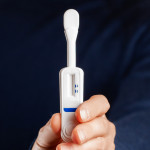Isentress (raltegravir) appears to work just as well as Sustiva (efavirenz), with fewer drug-related side effects, in HIV-positive patients starting antiretroviral (ARV) therapy for the first time, according to a 48-week Phase III study analysis reported yesterday at the 2008 joint meeting of the Interscience Conference on Antimicrobial Agents and Chemotherapy (ICAAC) and the Infectious Diseases Society of America (IDSA). The latest results mirror those of a 96-week Phase II study reported at the XVII International AIDS Conference (IAC) this past summer in Mexico City.
Merck’s STARTMRK clinical trial treated 281 first-time ARV takers with 400 mg Isentress twice daily and 282 with 600 mg Sustiva once daily. Patients also received Truvada (tenofovir plus emtricitabine). At the start of the study, viral loads averaged slightly more than 100,000 copies in both treatment groups. The average pre-treatment CD4 count was 218, and about 47 percent of patients in both groups had CD4s below 200 cells.
Jeffrey Lenox, MD, of Emory University in Atlanta, reported at ICAAC/IDSA that after 48 weeks of treatment, about 86 percent of those taking Isentress and Truvada had viral loads below 50 copies, compared with 82 percent of those in the Sustiva group. The difference between the two groups was not statistically significant, meaning it could have been due to chance.
There was a more significant change in CD4 cell counts among those taking Isentress, reported as a 189-cell increase in the Isentress group and a 163-cell increase in the Sustiva group after 48 weeks.
Drug-related adverse events were more frequent in the Sustiva group (77 percent) compared with the Isentress group (44 percent), including moderate-to-severe side effects (32 percent versus 16 percent, respectively).
Not surprisingly, central nervous system side effects, including difficulty concentrating and vivid dreams, were more common in the Sustiva group (17.7 percent) versus Isentress group (10.3 percent).
Total cholesterol increased by 18 mg/dL in the Isentress group, compared with 33 mg/dL in the Sustiva group. Levels of “good” HDL cholesterol increased in both groups, with a 4 mg/dL increase among those taking Isentress and 10 mg/dL among those taking Sustiva. Levels of “bad” LDL cholesterol increased as well, by 6 mg/dL in the Isentress group and 16 mg/dL in the Sustiva group.
The most notable difference involved changes in triglyceride levels after 48 weeks—there was a 3 mg/dL decrease in the Isentress group, compared with a 37 mg/dL increase in the Sustiva group.
In conclusion, Dr. Lennox indicated that in treatment-naïve patients given 48 weeks of therapy, the combination of Isentress and Truvada had similar ARV activity to Sustiva plus Truvada and was associated with greater CD4 cell gains and few CNS-related side effects. He also noted that a clinical trial of once-daily Isentress in first-time treatment takers is ongoing.
Advertisement
Advertisement
Advertisement






2 Comments
2 Comments